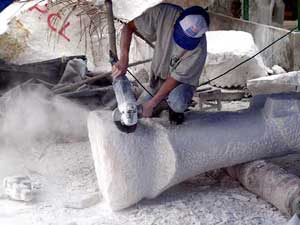In the past decade, the lives of over 400 households engaged in production and business in the Non Nuoc stone carving village, located in Ngu Hanh Son District, Da Nang, have significantly improved. However, this enhancement of material living conditions has come at the cost of a persistent struggle with environmental pollution. It is not an exaggeration to describe the pollution here as comprehensive, encompassing noise pollution, air pollution, and most alarmingly, water pollution.
 |
| Noise, air, and water sources are all polluted in Non Nuoc stone village (Photo: VNN) |
There has never been a comprehensive and accurate assessment of the damage caused by this pollution, and its consequences undoubtedly affect not just the current generation of residents but also future ones. Approximately 500 tons of stone are processed daily, resulting in an estimated 70 kg of dust released into the air each day—a figure that is likely underestimated. This does not account for the dust generated during the stone crushing process or from the hundreds of trucks entering and leaving the craft village.
Around 20% of stone workers suffer from occupational deafness, while residents have become accustomed to the constant noise from drilling, cutting, stone chiseling, and sawing, whether they like it or not. There are no precise figures regarding the impact of noise pollution on the health of Non Nuoc residents, but the detrimental effects are evident.
Acid is an essential material used for smoothing stones. Visible consequences include skin irritation and sores, but the more dangerous aspect is that acid seeps into the dust in the air, posing long-term health risks through inhalation.
Each day, approximately 700 liters of acid are used. Annually, this amounts to 25,000 liters of acid leaching into the ground. Meanwhile, nearly 100% of the local population still relies on well water for their daily activities.
Mr. Nguyen Dinh Thu, Deputy Chairman of the Ngu Hanh Son District People’s Committee, stated: “Currently, dust and noise pollution cannot be remedied. We are seeking the city’s approval for a designated area for stone storage and cutting to reduce noise, while dust control measures are limited to barriers.”
A project aimed at reducing environmental pollution in the craft village was approved in 2003 and was launched with much fanfare. Nearly three years later, only a short section of road has been constructed. The residents continue to live amidst stone dust, enduring noise pollution, and using contaminated water as they have in the past.


















































